 |
 |
 |
 |
 |
 |
| |
 |
|
 |
 |
 |
  |
  |
 |
 |
 |
 |
|
|
 |
|
 |
 |
 |
BUILDING |
 |
|
 |
|
 |
 |
 |
| |
 |
| 
 |
Residential Area at Pelargonienweg
Life at the fruit grove |
|
 |
 |
 |
 |
DESIGNER |
 |
|
|
 |
|
 |
 |
 |
| |
 |
|
 |
 |
 |
 |
DESCRIPTION |
 |
|
|
 |
|
 |
 |
 |
| Urbanistic concept |
 |
|
 |
|
 |
 |
 |
|
 |
|
|
|
 |
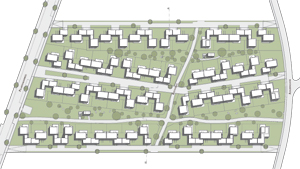 The plot is to be found in the North West of Vienna’s 22nd district. It is characterised by a broadly even landscape which has been predominantly used for agricultural purposes in recent years. It is bordered by the streets Azaleengasse to the North and Pelargonienweg to the South; the land to the East and West is used for agriculture. The plot is to be found in the North West of Vienna’s 22nd district. It is characterised by a broadly even landscape which has been predominantly used for agricultural purposes in recent years. It is bordered by the streets Azaleengasse to the North and Pelargonienweg to the South; the land to the East and West is used for agriculture.
Access by motorised transport takes place by means of the aforementioned roads. The site can be reached by public transport by bus – lines 24A and 95B.
There are two footpaths which cross the plot and arrange it into 4 subsections.
The longitudinal alignment of the construction sites is in North-South direction.
Two day care facilities are nearby on Breitenleerstraße, a public centre is foreseen to the West. There is a school and a kindergarten can be found 2.5 km away, together with a chemists and a post office. For leisure activities, a lake for bathing and a sports field are 2.5 km away in Hirschstetten.
Businesses for general supplies can be found in the Kagran business park as well as Stadlau Business Park and in the Rennbahncenter. |
|
 |
 |
 |
|
 |
|
|
|
 |
|
 |
 |
 |
|
 |
|
|
|
 |
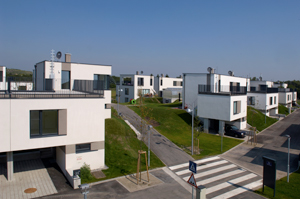 A parallel linear-type structure was chosen in the first instance. This enables an alignment – and in doing so provides exposure to sunlight of the structures and the open spaces in front of them in the east-west direction. A parallel linear-type structure was chosen in the first instance. This enables an alignment – and in doing so provides exposure to sunlight of the structures and the open spaces in front of them in the east-west direction.
The development of an urbanistic approach in a new definition of landscape, site development and building structures allows the creation of new quality focuses in a predominantly undeveloped and respectively non-densely developed area.
The alignment of the construction site in north-south direction paves the way for an appropriate alignment of the buildings.
In the second approach, the parallel arrangement of the site, with the exception of the perimeter development, is broadly left behind, through a sweep of the directions the interspaces open up which are predominantly the common green spaces, the “fruit grove” (“Obsthain”). To give the landscape a strong identity-creating character, the site topography is transformed into a gentle dune-like landscape. This takes place solely by the redeployment of the earth on the site through excavation and landfill. This avoids the excavated earth having to be transported away. There are also common spaces in this gentle hilly landscape which could be used, for example, for green houses, must cellars, and playgrounds.
All of the thoroughfares on the site shall be designed in a manner which promotes traffic calming. These enable driving across the property and accessibility within walking distances. These roads shall be private, sweeping from side to side at certain intervals and receive a structured configuration, so reducing the speed at which cars can drive across the property in a simple way.
The whole site shall be pervaded with footpaths, through which the chosen ground topography lie above the roads and shall contribute to a significant improvement in safety for the residents. |
|
 |
 |
 |
|
 |
|
| Structure typology |
 |
|
 |
We obtain the opportunity to develop our buildings “on the slope” through the newly created three-dimensional landscape. The construction “plays” with the slopes in the landscape and a number of configurations through various combinations of the two basic types, each bringing its own particular qualities.
We hereby achieve a differentiated and rhythmical building typology which in a sequence of linked and free standing combinations of the buildings creates ever changing townscapes. In doing so, particular attention is paid to a relaxed ground floor zone, the contact areas of the building are reduced and a visual connection of the transportation spaces with the garden landscape through the construction is made possible. |
|
 |
 |
 |
|
 |
|
| Building typology |
 |
|
 |
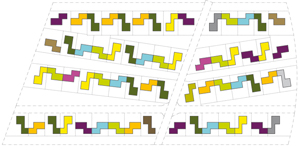 The developed building forms enable an optimised alignment of the common areas through a high differentiation. Through the minimising of the depths of the buildings provide the living spaces with a high degree of exposure to sunlight, alignment and orientation. In addition, there are no interventions inside the buildings for carrying the structure. The small span lengths of the ceiling panels enable a large degree of flexibility in the floor plan – an ideal stating basis for customised development, from the loft apartment to apartments with a number of rooms. Part of the roof spaces can be accessed and used in various ways, for example as a vegetable patch of a roof terrace. The developed building forms enable an optimised alignment of the common areas through a high differentiation. Through the minimising of the depths of the buildings provide the living spaces with a high degree of exposure to sunlight, alignment and orientation. In addition, there are no interventions inside the buildings for carrying the structure. The small span lengths of the ceiling panels enable a large degree of flexibility in the floor plan – an ideal stating basis for customised development, from the loft apartment to apartments with a number of rooms. Part of the roof spaces can be accessed and used in various ways, for example as a vegetable patch of a roof terrace.
The arranged open spaces are attributed to the covered roads, footpaths and cycle paths as well as the open but covered parking spaces and the garden and terrace spaces which bring about various qualities of allocation and orientation according to the shape of the ground. There are no fences – either between the gardens or bordering the common green spaces – with the clear aim of enabling smooth transitions between the spaces. Through the grouped alignment of the buildings, particularly suitable building typologies occur whose arrangement makes them ideal for multi-generation residences and large families.
Apartment sharing for senior citizens could also be created. Those buildings which have the possibility of creating a ground level, barrier free apartment would ideally lend themselves for granny-flats for people with simple care requirements. |
|
 |
 |
 |
|
 |
|
|
|
 |
|
 |
 |
 |
|
 |
|
| OPEN SPACE |
 |
|
 |
|
 |
 |
 |
|
 |
|
| Basic concept |
 |
|
 |
The settlement lies in a large meadow with fruit trees. The open space is characterised by a gently waved topography which through the redeployment of excavations on the site can be styled like dunes. So emerges a landscape on the outskirts of the town with a special identity: the houses are embedded in a space sequence of soft hills and troughs, in a grove of apple, pear, cherry and nut trees.
The chosen typographic idea is both an artistic and an ecological grasp of the space. It gains life from a dynamic “re-contextualisation of the existing” through the redeployment of the earth material on the site:
In the history of the cultural landscape of the marchfeld there has been marked riverbed characteristics, troughs and wandering dunes in a state of continual change.
|
|
 |
 |
 |
|
 |
|
| Swaying garden |
 |
|
 |
This connects the private and common spaces to form an organic whole, whereby the areas between the opposite rows of houses are formed in either as hills or as troughs. This creates both attractive views for the residents of the high lying areas and privacy for those on the lower floors. The landscape is flowing, the fruit trees are dispersed throughout the property.
The transition to those plots with terraces is accentuated through the implementation of open strips of hedges (red currant, gooseberry) or groups of shrubs (hazelnut). |
|
 |
 |
 |
|
 |
|
| Osmotic minor architecture and common spaces |
 |
|
 |
| Greenhouses can be found dotted around the landscape – transparent casings for common spaces whose potential usage varies along with the seasons, from which access to must cellars situated beneath them is provided. |
|
 |
 |
 |
|
 |
|
| Child’s play |
 |
|
 |
| This natural environment, with its troughs and hills in the meadow with fruit trees, partially dense and partially scattered, shrubs, hedges, and bushes, provides a wonderful setting for young adventurers to engage in spontaneous voyages of discovery, without needing technical equipment. In some of the lower areas of the site, small troughs underplayed with gravel can be found. During heavy rain small bodies of water shall be formed. A number of attractive and seasonally variable places to play are created which invite one to linger. |
|
 |
 |
 |
|
 |
|
| Garden terraces and ramps |
 |
|
 |
| You are led to the meadows of fruit trees by concrete blocks and lawn spaces: an equally private zone is created by the arrangement of the plant shrubs and berries, the intent being to create a flowing transition to the common spaces. |
|
 |
 |
 |
|
 |
|
| Roads and paths |
 |
|
 |
- roads are predominantly implemented at a width of 3.5m, they are made of asphalt with interspersed gravel and bordered by nut trees. Parking spaces for visitors shall be created by additional 2m wide strips between the buildings with interspaced paving which also act as places for passing.
- the open ground level parking spaces are also laid with this plaster, here with gravel fugues. - the pavements of stepping stones lie mostly above the level of the road and are without crossings over the road below due to the arrangement of the property. They are accompanied by apple quinces. |
|
 |
 |
 |
|
 |
|
| List of plants |
 |
|
 |
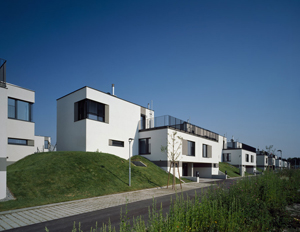 Fruit grove Fruit grove
Apples: “red russet”, “Cox’s orange”
Pairs: “Clapps Liebling”, “Bosc´s Flaschenbirne”
Quince: “giant quince of Vranje”
Cherries: “wild cherry“, “Van”
Walnut: “red Danube nut”
Threshold range and play areas
Hazelnut
Red currant: “Rolan”, “Black Chokeberry”
Gooseberry: “yellow Hinnomaeki”, “Captivator“
Raspberries from the autumn harvest
Turkish hazel
Strawberries “Spadeka” |
|
 |
 |
 |
|
 |
|
| PARTICIPATION |
 |
|
 |
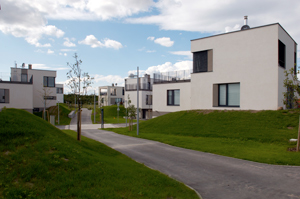 Co-determination and shared decision making shall take place on a number of levels: Co-determination and shared decision making shall take place on a number of levels:
- the chosen form of landscape design is based on the opportunities of collective decision- making. The creation of social interaction takes place with the planting and through the cultivation of the fruit trees (choice of trees, the processing of the fruit, bringing them to market). The must cellar (with the greenhouse above it) acts as a location for the processing of the harvested fruits and as a activity room for parties, games, “Heurigen” (“wine celebration”), etc. is a further important element.
- common maintenance of the open spaces with the inclusion of engaged pensioners and young people
- common decision-making regarding the transitions between the various areas of usage
- we offer the game of boules as a community activity for young and old which could positively promote neighbourliness.
- a system for the maintenance and care of the common spaces (mowing of the lawns, watering the plants, clearing snow, etc.) shall be developed in a process of participation with the residents. |
|
 |
 |
 |
|
 |
|
| ECONOMICS |
 |
|
 |
|
 |
 |
 |
|
 |
|
| Mass balancing |
 |
|
 |
| All of earth needed for the development of the landscape shall come from within the site – reducing the need for haulage significantly. This is evidenced and proved in two representative subsections. |
|
 |
 |
 |
|
 |
|
| Buildings typologies |
 |
|
 |
| The possible combinations of the two ground types provide a number of different construction types. |
|
 |
 |
 |
|
 |
|
| Flexibility |
 |
|
 |
| The small span lengths of the ceiling panels enable a large degree of flexibility in the floor plan – an ideal stating basis for customised development, from the loft apartment to apartments with a number of rooms. |
|
 |
 |
 |
|
 |
|
| Self-finishing |
 |
|
 |
In tune with the philosophy of a “residents’ movement”, residents shall be given the opportunity to complete the design and implementation of important parts of the dwellings such as the walls and floors themselves.
In addition, type B includes the option of adding a second bathroom – the necessary pipes and connections can be laid on request.
Due to restrictions in the applicable housing promotion law, the client can unfortunately not be offered a higher degree of self-finishing. |
|
 |
 |
 |
|
 |
|
| Access roads |
 |
|
 |
The access roads shall be constructed and later maintained by the developer. Here, we aim to engage ambitious residents in the maintenance of the estate and, in doing so, reduce maintenance costs.
|
|
 |
 |
 |
 |
 |
 |
 |
ECO-SUSTAINABILITY |
 |
|
|
 |
|
 |
 |
 |
| Environmental impact |
 |
|
 |
| All of earth needed for the development of the landscape shall come from within the site – reducing the need for haulage significantly. |
|
 |
 |
 |
|
 |
|
| Building materials |
 |
|
 |
| The construction of the buildings above the entrance and cellar floors which are partially built into the slope takes place in massive construction; the windows are made from wood and aluminium. |
|
 |
 |
 |
|
 |
|
| Microclimate |
 |
|
 |
A number of measures serve to improve the microclimate:
- development of a raised topography acts as a wind breaker
- the creation of seepage troughs
- the meandering structures enable different microclimatic environments via the creation of courtyards (light-shade, ventilation) |
|
 |
 |
 |
 |
 |
 |
 |
LOCATION |
 |
|
|
 |
|
 |
 |
 |

|
 |

|
Continent |
|
 |
|
Nation |
|
 |
|
State |
|
 |
|
Town |
|
 |
|
Neighborhoods |
|
 |
|
Address |
|
 |
|
|
|
 |
|
 |
 |
 |
 |
MAP |
 |
|
|
 |
|
 |
 |
 |
| |
 |
|
 |
 |
 |
 |
|
TYPOLOGY |
 |
|
|
 |
|
 |
 |
 |
|
|
 |
ARCHITECTURE | Residential buildings
Detached, semi-detached houses and villas
Multiple dwelling
| |
 |
 |
 |
 |
CHRONOLOGY |
 |
|
|
 |
|
 |
 |
 |
Project |
 |
|
 |
| 
 |
2005 - 2006
project winner of competition
|
|
Realisation |
 |
|
 |
| 
 |
2007 - 2009 |
|
 |
 |
 |
 |
AMOUNT |
 |
|
|
 |
|
 |
 |
 |
| |
 |
|
 |
 |
 |
 |
DIMENSIONAL
DATA |
 |
|
|
 |
|
 |
 |
 |
| Number |
 |
|
 |
| 61 single occupancy houses |
|
| Surface |
 |
|
 |
plot sq.m. 23.582
gross floor sq.m. 11.538
built up sq.m. 4.880
usage sq.m. 8.300 |
|
| Volume |
 |
|
 |
|
 |
 |
 |
 |
STRUCTURES |
 |
|
|
 |
|
 |
 |
 |
| |
 |
|
 |
 |
 |
 |
LANDSCAPE DESIGN |
 |
|
|
 |
|
 |
 |
 |
| |
 |
| Auböck+Kárász landscape architects |
|
 |
 |
 |
 |
STAFF |
 |
|
|
 |
|
 |
 |
 |
|
 |
|
Project management |
 |
|
Design team |
 |
| Alice Mayer, Martin Mostböck, Stefan Pfefferle, Holger Schäfer, Katrin Steinbacher, Mark Steinmetz |
|
Developer |
 |
| Heimbau Gemeinnützige Bau-, Wohnungs- und Siedlungsgenossenschaft, Reg. Gen.M.B.H. |
|
Physical engineering |
 |
|
Construction supervision |
 |
| Heimbau Gemeinnützige Bau-, Wohnungs- und Siedlungsgenossenschaft, Reg. Gen.M.B.H. |
|
Systems |
 |
|
Electrical engineer |
 |
|
 |
 |
 |
 |
CREDITS |
 |
|
|
 |
|
 |
 |
 |
| |
 |
Photos © Lisa Rastl
Drawings © JWA Josef Weichenberger architects
Text edited by JWA Josef Weichenberger architects
Courtesy by JWA Josef Weichenberger architects
|
|
 |
  |
 |